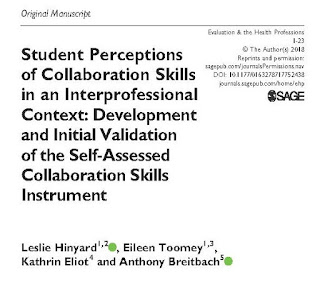Scholarship in an Introductory Interprofessional Course
By: Katie Eliot PhD, RDN
For the past three years, we have been blessed to co-teach a large, introductory interprofessional education course, IPE 1100 - Introduction to Interprofessional Healthcare.
While this has largely been a journey in figuring out how to engage 200+ freshmen learners (sometimes even at 8am!), what I’ve enjoyed most about this teaching venture has been the research aspect of our work.
Tony and I decided early on that we would approach the course with a strong emphasis on the scholarship of teaching and learning. As a result, we have presented our work at multiple conferences on the pedagogy we use in the course and have published two peer-reviewed papers on the validation of an instrument we used to measure collaboration in these students.
I’ll give you a little synopsis of these projects…
Self-Assessed Collaboration Scale (SACS)
With our colleague Dr. Leslie Hinyard as well as research assistant/statistician Eileen Toomey (a key member of any research project!) we developed and validated the Self-Assessed Collaboration Scale (SACS), that allows students to evaluate their readiness to work in teams. This brief survey is useful in a variety of team-based contexts including didactic and clinical scenarios.
A paper on this process was published in Evaluation and the Health Professions in January 2018:
http://journals.sagepub.com/doi/full/10.1177/0163278717752438
Using the SACS in IPE 1100
Once the SACS was validated, we used the instrument to see how our students perceived their readiness to work in teams. We were pleased to see that after a semester in our course, students’ rated themselves as being more prepared for collaboration. This is good news to know that we are setting our students up for success in future IPE courses – win-win!
These data were presented in Health and Interprofessional Practice in May 2018.
https://commons.pacificu.edu/hip/vol3/iss3/3/
For me, the best parts about embedding scholarship into teaching are:
Finally, I would encourage anyone who teaches to think about what they can measure and to get their results out there in the literature. Even think about writing up your process – others are always looking for “best practices” and ideas for making their teaching more effective.
Good luck and enjoy turning your teaching into research!
By: Katie Eliot PhD, RDN
For the past three years, we have been blessed to co-teach a large, introductory interprofessional education course, IPE 1100 - Introduction to Interprofessional Healthcare.
While this has largely been a journey in figuring out how to engage 200+ freshmen learners (sometimes even at 8am!), what I’ve enjoyed most about this teaching venture has been the research aspect of our work.
Tony and I decided early on that we would approach the course with a strong emphasis on the scholarship of teaching and learning. As a result, we have presented our work at multiple conferences on the pedagogy we use in the course and have published two peer-reviewed papers on the validation of an instrument we used to measure collaboration in these students.
I’ll give you a little synopsis of these projects…
Self-Assessed Collaboration Scale (SACS)
With our colleague Dr. Leslie Hinyard as well as research assistant/statistician Eileen Toomey (a key member of any research project!) we developed and validated the Self-Assessed Collaboration Scale (SACS), that allows students to evaluate their readiness to work in teams. This brief survey is useful in a variety of team-based contexts including didactic and clinical scenarios.
A paper on this process was published in Evaluation and the Health Professions in January 2018:
http://journals.sagepub.com/doi/full/10.1177/0163278717752438
Using the SACS in IPE 1100
Once the SACS was validated, we used the instrument to see how our students perceived their readiness to work in teams. We were pleased to see that after a semester in our course, students’ rated themselves as being more prepared for collaboration. This is good news to know that we are setting our students up for success in future IPE courses – win-win!
These data were presented in Health and Interprofessional Practice in May 2018.
https://commons.pacificu.edu/hip/vol3/iss3/3/
For me, the best parts about embedding scholarship into teaching are:
- The satisfaction of knowing that what you are doing in your classroom is producing the outcomes you are looking for. And if it’s not…that you can make changes and re-evaluate. As educators, we are constantly evolving and the best way to make sure what you are doing is effective is to measure it!
- Sharing your work with others who are excited about it. There’s nothing like chatting with colleagues from across the country who are genuinely interested in what you are doing. The more you talk about your work, the more ideas you get and the next thing you know, another study is born! In fact, we are just getting started on a multi-institution study to look at entry-level learners using the SACS and other validated instruments. More to come about that project in a future post!
Finally, I would encourage anyone who teaches to think about what they can measure and to get their results out there in the literature. Even think about writing up your process – others are always looking for “best practices” and ideas for making their teaching more effective.
Good luck and enjoy turning your teaching into research!




